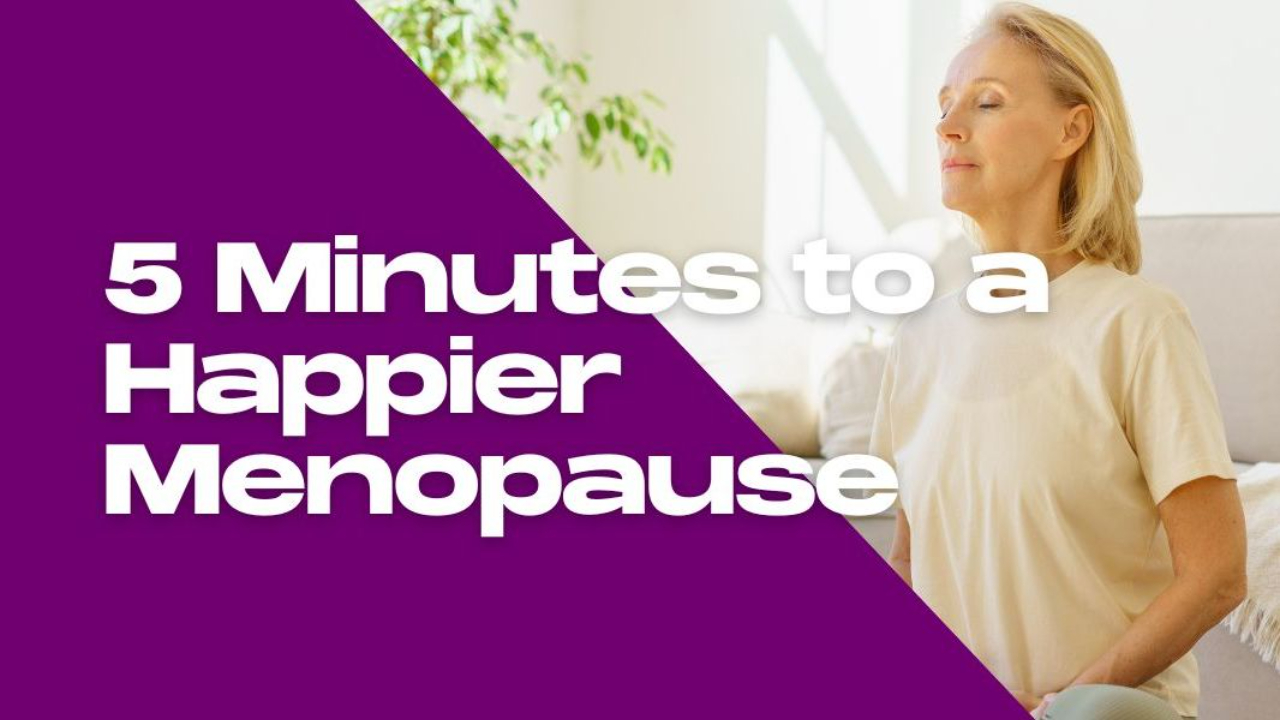
5 Minutes to a Happier Menopause
May 23, 2023Spending just a few minutes a day in mindful meditation can help ease many menopause symptoms.
By Selene Yeager
Mindfulness comes up all the time in the menopause sphere. That’s because as your hormones fluctuate and drop, they can take your peace of mind with them, leaving you more prone to feeling anxious, irritable, and depressed. That’s where we can use a daily dose of mindfulness, which sounds "new-agey" and honestly, too good to be true, which is why I suspect many women (myself included for years) don’t even bother.
But the research is clear and consistent that it makes a difference. A study of 1,744 women ages 40 to 65 published in Climacteric: The Journal of the International Menopause Society found that women who scored higher on the Mindfulness Attention Awareness Scale (MAAS), which measures our levels of distraction and preoccupation, had lower menopause symptom scores for irritability, depression, and anxiety.
Mindfulness meditation also improves sleep and other menopausal symptoms, including hot flashes. In a 2018 study of postmenopausal women with insomnia, eight weeks of mindfulness meditation training improved sleep quality, quality of life, attention levels, and reduced vasomotor symptoms like hot flashes and night sweats.
The Secret is Lowering Stress
Mindfulness works because it lowers stress. Levels of your stress hormone cortisol can increase as you make your way into the later stages of the menopausal transition, according to research. And women with increased cortisol levels at this time are more apt to have severe vasomotor symptoms like night sweats and hot flashes, which have been linked to cardiovascular disease risk in other research.
Practiced daily, mindfulness can lower stress not just in the moment, but long term, according to a study on more than 200 women and men (mostly women) who participated in a nine-month mindfulness training program.
The proof was in the participants' hair. The concentration of cortisol in hair is a measure of exposure to prolonged stress. The longer the stress lasts, the longer an increased concentration of cortisol circulates around the body, the more it accumulates in our hair. On average, hair grows one centimeter per month. The researchers analyzed the amount of cortisol in the first three centimeters of hair, starting at the scalp, every three months over the course of the nine-month study.
After just six months of training, the amount of cortisol in the participants’ hair had decreased significantly, on average by 25 percent.
A mindfulness practice is especially useful for menopausal endurance athletes. Intense aerobic exercise, especially endurance sports, activates our fight-or-flight, sympathetic nervous system, and that repeated exposure (especially without proper recovery, which takes longer in midlife and menopause) elevates cortisol levels. Past research on long-distance runners, triathletes, and cyclists has found that these endurance athletes have higher cortisol levels in hair samples compared to their peers who don’t engage in endurance sports.

How to Practice Mindfulness
Some people ironically get stressed out about practicing mindfulness because they don’t really know what it means or how to do it and it feels like one more thing to try to make time for in an already packed day. But it really doesn’t have to be time-consuming or complicated. It’s something you can slip into your day when you’re feeling frazzled, during a coffee or meal break, when you first open your eyes in the morning, or anytime you have a moment where you can just sit and breathe. Because that’s all you need to do. Sit and breathe.
Mindful.org recommends settling down in a place that feels calm (if that means locking yourself in the bathroom for a few minutes, so be it!), setting a timer for 5 minutes, and focusing on your breath. Your mind will naturally wander, but just nudge it back to your breath, without worrying that you’re “not doing it right” because you have thoughts floating around.
To really hone in on the relaxation response, make your exhalation longer than your inhalation, advises Hit Play Not Pause guest Jill Miller, author of Body by Breath. “No matter what the duration of your inhale, as long as you’re going with a longer exhalation, you’ll be accelerating the input of the vagus nerve to decelerate your heart rate. So inhale, then blow out the candles. Inhale, blow out the candles, repeat.”
Again, you only need five minutes, which may feel like “clickbait” for a headline (and it does make a nice headline), but if you’ve ever actually just sat and breathed for five minutes, it’s not an insignificant amount of time. And a study on mindfulness meditation in stressed-out healthcare professionals found that seven days of practicing five minutes of mindfulness meditation significantly reduced their stress levels, and there was a significant inverse correlation between mindfulness and stress.
Personally, I try to practice mindfulness the moment my eyes open and before I touch my phone. I take deep breaths, noticing the light coming through the window, the softness of the blankets and my pillow, the warmth of my cat snuggled next to me, even my husband's soft snoring to quiet my mind before the day begins. I’ll try to take a few moments mid-afternoon between meetings and assignments as well. But if that doesn’t happen, I have started the day off in a relaxed state of mind that carries into the day.
Get Feisty 40+ in Your Inbox
We hate SPAM. We will never sell your information, for any reason or send you emails that suck!


